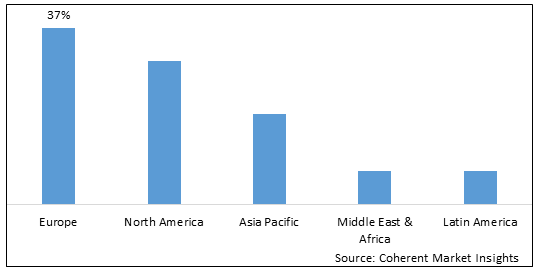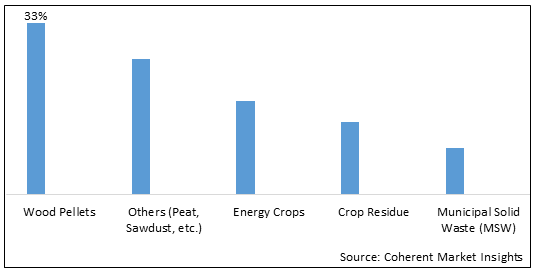Biomass Solid Fuel Market is estimated to be valued at USD 315.77 Bn in 2025 and is expected to reach USD 603.69 Bn in 2032, exhibiting a compound annual growth rate (CAGR) of 9.7% from 2025 to 2032.
Global Biomass Solid Fuel Market: Drivers
Increase in use of biomass solid fuel in various industries
Biomass is used for sustainable energy production as preferred by scientists, investors, and policymakers to provide solutions to growing energy crisis, and to reduce the environmental impact due to high greenhouse gas emission. Rising demand for biomass solid fuel from multiple industries across the globe is expected to drive the market growth. Since the start of the industrial revolution, fossil fuels have dominated the world's energy supply. Oil, gas, and coal are the major source of energy globally, however, due to high depletion rate of fossil fuels, there is a need for better energy resource that can safely replace fossil fuels and offer minimum carbon footprint.
The U.S. Department of Energy studied the impact of both fossil fuels and biomass solid fuels on global warming during the life-cycle of a power generation facility. It was found that using biofuel over coal, even when the carbon from burning coal is sequestered, leads to 148% reduction in the global warming potential of a power plant. Biomass solid fuel is the most suitable replacement for fossil fuels. These factors are expected to drive the global biomass solid fuel market growth during the forecast period. Besides, biomass solid fuel contributes to the largest share in the global bioenergy production.
No additional procedure required for processing biomass solid fuel
The major advantage of biomass solid fuel is that no typical production process is required in most of the cases, as it is often available in an appropriate form. It is available in the nature in its usual form. The issue with biomass, particularly wood chips and sawdust, is that they are inconvenient to transport in their natural state; as a result, they undergo a process called densification. . Through this process, the biomass is compressed into a solid form by mixing it with bonding agents to hold it together for convenient storage, transport, and use. Densified biomass is generally stored in the form of pellets and bricks.
Global Biomass Solid Fuel Market: Restraints
Direct burning causes Greenhouse Effect
Although biomass solid fuel is an alternative to non-renewable energy resources, the usage of biomass for direct burning has few disadvantages. The initial biomass is a sparse heterogeneous material that consists of pieces of various sizes with different calorific values. These features of biomass causes serious problems while burning solid biofuel in combusting chambers. For instance, the low bulk density of the biomass leads to reduced efficiency of the combustion. Although burning of biomass solid fuel does not emit enough carbon dioxide that would cause greenhouse effect, and thus, biofuels produce nitrous oxide on burning that can cause greenhouse effect. These factors are expected to hamper the market growth during the forecast period.
Global Biomass Solid Fuel Market: Opportunity
Rise in industrial production leads to greenhouse gas emission
The emission of greenhouse gases such as carbon dioxide, methane, and nitrous oxide continuously increasing due to rising industrial production in emerging economies. This is due to high investment costs involved in the adoption of green technologies and renewable resources. Solid biomass fuel can be used as one of the alternatives to stop the consumption of fossil fuels. According to VDEW- German Verband der Elektrizitaetswirtschaft, a Germany-based electricity association, the potential of available biomass in the world is equivalent to produce more than 150 billion mg per year, which is equivalent to 120 billion mg of coal. The potential for using this biomass solid fuel as an energy source is enormous. However, only 20–30% of the available biomass is useful.
Need for infrastructure to develop bioenergy for world
There is huge opportunity for the energy companies to invest in the infrastructure to develop bioenergy to fulfil world energy requirement by using solid biomass. Forest products are being used increasingly as a source of energy. Biomass solid fuel offers lucrative opportunities not only for climate change mitigation but also for harnessing energy crops, waste, degraded lands, and co-farming, and thus, creating wealth and employment and increase energy dependence.
Global Biomass Solid Fuel Market: Trends
Increase in consumption of fossil fuels
Increasing industrialization, and economic development leads to high consumption of fossil fuels. Fossil fuel reserves are limited, and these are depleting at an alarming rate. Biomass solid fuel along with other renewable energy resources are expected to be the potential alternatives of fossil fuels. Nowadays, bagasse and other agricultural residues are commonly used to produce power and heat in Brazil, and thus, demand for biomass solid fuel is rising.
Biomass Solid Fuel Market Report Coverage
| Report Coverage | Details | ||
|---|---|---|---|
| Base Year: | 2024 | Market Size in 2025: | USD 315.77 Bn |
| Historical Data for: | 2020 To 2024 | Forecast Period: | 2025 To 2032 |
| Forecast Period 2025 to 2032 CAGR: | 9.7% | 2032 Value Projection: | USD 603.69 Bn |
| Geographies covered: |
|
||
| Segments covered: |
|
||
| Companies covered: |
Svenska Cellulosa Aktiebolaget SCA, BTG Biomass Technology Group, Eni S.p.A., Fulcrum BioEnergy, SOCOTEC Group, Drax Biomass Inc., Aggregated Micro Power Holdings plc, PVM Environmental Products, VGrid Energy Systems, and Vattenfall AB |
||
| Growth Drivers: |
|
||
| Restraints & Challenges: |
|
||
Uncover macros and micros vetted on 75+ parameters: Get instant access to report
Global Biomass Solid Fuel Market: Recent Developments
In November 2021, BTG Biomass Technology Group and ABATO Motoren B.V. have achieved a significant milestone in their efforts to modify an internal combustion (diesel) engine to enable the use of Fast-Pyrolysis Bio-Oil (FPBO) by having their novel engine run for more than 500 continuous hours on FPBO that was mixed with 10% ethanol.
In February 2023, Fulcrum delivered the first railcar of landfill waste-derived syncrude in the world to its strategic partners Marathon Petroleum for conversion into fuel from the Sierra BioFuels Plant.
In 15 June 2023, The Science Based Targets initiative (SBTi) has verified Vattenfall's goal of having net-zero emissions in 2040 as the first Sweden-based energy company. This adds to Vattenfall's 2030 goals that support keeping global warming to 1.5°C.
In December 2022, Fulcrum BioEnergy, Inc., a clean energy pioneer in the development of renewable, drop-in transportation fuels from landfill waste, announced that it had successfully produced a low-carbon synthetic crude oil using landfill waste as a feedstock at its Sierra BioFuels Plant, the first commercial-scale landfill waste-to-fuels facility in the world.
Global Biomass Solid Fuel Market: Regional Analysis
In the global Biomass Solid Fuel market, Europe held the largest market share in terms of revenue. The rising demand for renewable energy sources in the area is to blame for this. According to the International Renewable Energy Agency (IRENA), Europe has seen an increase in installed biomass power capacity over the past ten years due to aggressive legislative initiatives. About half of the world's installed capacities are represented by it.
Figure 1. Biomass Solid Fuel Market Share (%), By Region, 2025

To learn more about this report, Request sample copy
On the basis of region, Europe dominates the global biomass solid fuel market with the 37% market share in terms of revenue, followed by North America and Asia Pacific, respectively.
Global Biomass Solid Fuel Market: Segmentation
Biomass solid fuel is divided into categories based on source, use, and end use. Additional categorization is carried out based on the following criteria: source (wood pellets, crop residue, energy crops, municipal solid waste, and others); application (space heating/cooling, cooking, heat processing, electricity generation, and others); and end use (industrial, institutional, and domestic).
On the basis of source, the global biomass solid fuel market is segmented into wood pellets, energy crops, crop residue, municipal solid waste (MSW), and others (peat, sawdust, etc.). In 2025, wood pellets segment accounted for 33% of the revenue share followed by others (peat, sawdust, etc.) and energy crops segments.
Figure 2. Biomass Solid Fuel Market Share (%), By Source, in 2025

To learn more about this report, Request sample copy
Global Biomass Solid Fuel Market: Impact of Coronavirus (COVID-19) Pandemic
The market for biomass solid fuels has been severely affected by COVID-19. Manufacturing operations have been suspended across all sectors of the economy. The need for a constant supply of heat and electricity to end users and the critical importance of energy security have been recognized by nations all over the world. The current essential and on-demand energy sources include wood chips, bagasse, and pellets. Governments all over the world are implementing recovery plans in response to the pandemic, but it's critical to recognize that climate change represents the greatest danger to humanity. The main pillars of the government's plans to promote economic growth and move toward a sustainable future should be renewable energy and bioenergy sources.
Global Biomass Solid Fuel Market: Key Companies
Key Companies operating in global biomass solid fuel market are Svenska Cellulosa Aktiebolaget SCA, BTG Biomass Technology Group, Eni S.p.A., Fulcrum BioEnergy, SOCOTEC Group, Drax Biomass Inc., Aggregated Micro Power Holdings plc, PVM Environmental Products, VGrid Energy Systems, and Vattenfall AB.
*Definition: Biomass is defined as the biologically degradable fraction of products, residues, and wastes from remains of animals and plants, and biological remains of household and industrial waste. Biomass is a renewable energy resource that can be derived from the carbonaceous waste of human, animals, and other industrial activities. It acts as a constant source of energy that can never be depleted.
Share
Share
About Author
Yash Doshi is a Senior Management Consultant. He has 12+ years of experience in conducting research and handling consulting projects across verticals in APAC, EMEA, and the Americas.
He brings strong acumen in helping chemical companies navigate complex challenges and identify growth opportunities. He has deep expertise across the chemicals value chain, including commodity, specialty and fine chemicals, plastics and polymers, and petrochemicals. Yash is a sought-after speaker at industry conferences and contributes to various publications on topics related commodity, specialty and fine chemicals, plastics and polymers, and petrochemicals.
Missing comfort of reading report in your local language? Find your preferred language :
Transform your Strategy with Exclusive Trending Reports :
Frequently Asked Questions
Select a License Type
Credibility and Certifications

860519526

9001:2015
27001:2022


Joining thousands of companies around the world committed to making the Excellent Business Solutions.
View All Our Clients
US Reciprocal Tax Impact Analysis On Biomass Solid Fuel Market
Stay updated on tariff changes with expert insights and timely information